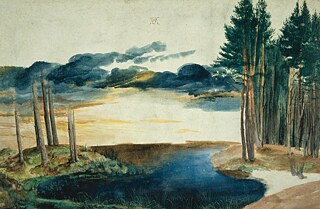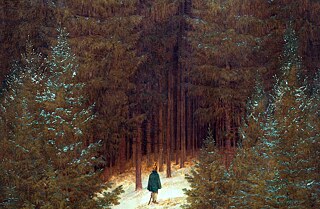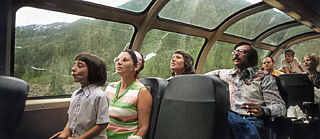The forest has shaped German society for centuries: from the wood shortage of the Middle Ages, to the forest as a source of identity in the Romantic period, to the so-called "Waldsterben" of the 1980s. On the occasion of the International Day of Forests, we take a look at its history.
The big scare issue for Germans in the 1983 election campaign was the so-called "Waldsterben", the forest dieback. All the political parties put it on their agendas, and the Greens entered the Bundestag for the first time that year. The newly elected Chancellor, Helmut Kohl, also highlighted the alarming damage to forests and their importance for water, health, the climate and Germany's cultural landscape.Across Europe, however, the Germans were almost alone in their concern. Only in Austria and Switzerland did the fear spill over. In France, on the other hand, people tended to look at their German neighbours with pity when people talked about acid rain and 'Le Waldsterben' - even though there was comparable evidence of dying forests.
The fact that the issue has taken hold in Germany may also have something to do with the country's history. After all, German life and culture have always been closely linked to the forest.
Wood Characterises the Middle Ages
In the Middle Ages, the forest was as important a source of wood as oil is today. People needed wood to build houses, bridges and ships, to heat their homes and to make carriages and barrels. There were also several important mining regions in Germany. This also required large amounts of wood, for example to stabilise shafts or to smelt iron.As the forests became increasingly sparse, people realised that wood was not available in unlimited quantities and that they were dependent on nature. Fast-growing cities in particular needed a lot of wood - for example, 20,000 trees had to be felled to build the Frauenkirche in Munich. Forest protection measures were introduced to ensure that the demand for wood could be met in the future. It was forbidden to allow animals to graze in the forest, and those who cut down trees were severely punished.
Mixed forests, which had characterised Germany until the Middle Ages, were greatly reduced due to the enormous demand for wood. By 1400, only a quarter of Germany's total area was forested. By comparison, today a third of Germany is covered by forest.

Albrecht Dürer - "Der Weiher im Walde", 1497 | Picture: picture alliance / akg-images | akg-images
Due to the scarcity of wood as a resource, the concept of sustainability was first considered in Germany: In 1713, when the area around Freiberg in Saxony was almost completely deforested to make way for silver mines, Oberbergrat Hans Carl von Carlowitz called for the 'continuous, constant and sustainable use of forests'. He was not only referring to the environment, but also to the economic and social aspects. He wanted to protect the poor as well as future generations.
The Myth of the ‘German Forest’ in the Romantic Period
The great demand for timber in Germany brought with it forest protection measures, knowledge of reforestation methods and the concept of sustainability. But the forest also shaped German society and culture in other ways.During the Romantic period, the forest was mythically charged and glorified as a symbol to differentiate the Germans from other nations. This can be traced back to the long-dead Roman historian Tacitus and his stories about the Germanic tribes. Tacitus described how the Romans once fought against the forest dwelling Germanic tribes and how intimidating the wooded region of the Germanic tribes was.
Although we now know that Tacitus himself never travelled to Germania and that his accounts were politically charged stories from the Roman Empire, they were regarded as a historical source at the beginning of the 19th century and were passed on as fact until the 20th century.
Stories of the heroic Germanic tribes associated with the wars of liberation against Napoleon in the 19th century made the forest a symbol of the Germans for the Romantics. Writers such as Heinrich Heine and Ludwig Tieck coined the term "Waldeinsamkeit" (solitude in the forest), the Grimm Brothers' fairy tales were created, and Caspar David Friedrich painted the "The Chasseur in the Forest" , showing a French soldier surrounded by large, dense trees. The myth of the "German Forest" was born.

Detail of the painting by Caspar David Friedrich - Chasseur in the Forest, 1814 | Picture: picture-alliance / akg-images | akg-images
The "people of the forest" under National Socialism
The stories of the Germanic tribes were taken up by the National Socialists and the "German forest" was politicised. For Nazi propagandists, the Germans were the "people of the forest", and the love of the forest was declared to be something purely German. Jews, on the other hand, were labelled as "people from the desert" who were harmful to the forest.Even the expansion of the Nazi autobahns was linked to the "German forest": The roads and the so-called "autowandering" were supposed to give the Germans effective access to nature. The fact that countless trees were destroyed for the construction of the autobahn was left out of the narrative.
Forest Dieback in the 80s and Today
The political instrumentalisation of the forest decreased in the post-war period. Instead, the forest was chosen as a retreat from the bombed-out cities, offering recreation.It was not until the 1980s that the forest returned to the centre of political debate for ecological reasons. "The forest is dying" (Der Wald stirbt) was the headline in Der Spiegel, and acid rain and exhaust fumes were identified as the causes of forest dieback. As a political response to public pressure, the Kohl government introduced environmental standards that drastically reduced pollution. The predicted forest dieback did not occur. Whether the forest dieback would have occurred without these measures is debatable. However, it is known that the regulations introduced significantly improved air quality.

Demonstration about forest dieback in the Black Forest. Photo taken on 18 October 1986 | Pictue: picture-alliance / Friedemann Vetter | Friedemann Vetter
Yet there is no debate about forest dieback. Even though the forests are worse now than they were in the 1980s.
March 2025




